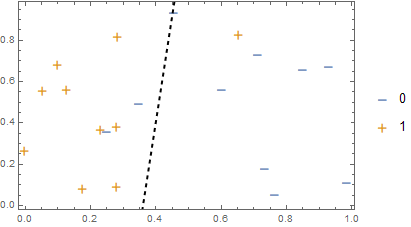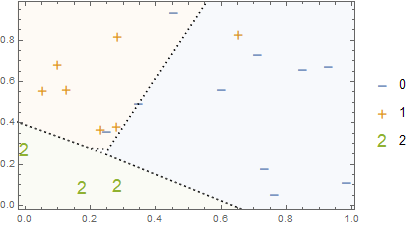Here' s a diagram we often see in machine learning. I want to construct something like it using the Wolfram Language and Classify, at least when the method is logistic regression. Here's how I go about it. 
Let' s generate some simple data.
SeedRandom[121217];
trainx = RandomReal[{0, 1}, {20, 2}];
trainy = Map[
If[LogisticSigmoid[{-2.7, 1.4}.# +
RandomVariate[NormalDistribution[0.3, 0.5]]] > 0.5, 1, 0] &,
trainx];
If our classification task does not require much complexity, we can use LogitModelFit and some algebra to find the boundary.
boundaryExpression[fm_FittedModel] :=
y /. Quiet@First@Solve[fm[x, y] == 1/2, y] // Expand;
boundaryExpression[lomf]
We find it is y=-3.69718 + 10.2671 x
We can now visualize the boundary and get a picture like the one above with the following code.
With[{be = boundaryExpression[lomf]},
Show[ListPlot[
KeySort[GroupBy[
MapThread[List, {trainx, trainy}], (ToString[Last[#]] &) ->
First]], PlotMarkers -> {{"-", 18}, {"+", 18}}, Axes -> False,
Frame -> True],
Plot[be, {x, 0, 1}, PlotStyle -> {Thick, Dashed, Black}]]
But all of that is using LogitModelFit. Sometimes we need regularization or other features of Classify. So, here's how we generate a similar picture using Classify.
cl = Classify[trainx -> trainy, Method -> {"LogisticRegression", "L1Regularization" -> 0,
"L2Regularization" -> 0}, TrainingProgressReporting -> None];
We get the probabilities for each class.
ci = ClassifierInformation[cl, "ProbabilitiesFunction"]
This generates a function that produces an Association:
Association[{0 -> (0.0307046 E^(8.58421 #1))/(
0.0307046 E^(0. + 8.58421 #1) + 0.675585 E^(0.836087 #2)),
1 -> 1./(1. + 0.0454489 E^(8.58421 #1 - 0.836087 #2))}] &
We can again use a little algebra to find the boundary.
boundaryExpression[a_Function] :=
y /. Quiet@
First@Simplify[Solve[Equal @@ a[x, y], y, Reals],
x \[Element] Reals];
boundaryExpression[cl_ClassifierFunction] :=
boundaryExpression[
ClassifierInformation[cl, "ProbabilitiesFunction"]]
We can now use this function to make a plot quite similar to the one above.
With[{be = boundaryExpression[cl]},
Show[ListPlot[
KeySort[GroupBy[
MapThread[List, {trainx, trainy}], (ToString[Last[#]] &) ->
First]], PlotMarkers -> {{"-", 18}, {"+", 18}}, Axes -> False,
Frame -> True],
Plot[be, {x, 0, 1}, PlotRange -> {{0, 1}, {0, 1}},
PlotStyle -> {Dashed, Black}]
]
]
Here's another way that does not require use of algebra. Instead we rely on RegionPlot and Ordering.
Show[ListPlot[
KeySort[GroupBy[
MapThread[List, {trainx, trainy}], (ToString[Last[#]] &) ->
First]], PlotMarkers -> {{"-", 18}, {"+", 18}}, Axes -> False,
Frame -> True],
RegionPlot[
Ordering[ci[x, y], -1][[1]] == 1, {x, 0 - 1, 2}, {y, -1, 2},
PlotRange -> {{0, 1}, {0, 1}}, BoundaryStyle -> {Dashed, Black},
PlotStyle -> {Opacity[0], White}]
]
By using RegionPlot we can readily extend the production of boundary diagrams to situations involving more than two classes.
cl3 = Classify[trainx -> trainy2,
Method -> {"LogisticRegression", "L1Regularization" -> 0,
"L2Regularization" -> 0}, TrainingProgressReporting -> None];
ci3 = ClassifierInformation[cl3, "ProbabilitiesFunction"];
c3plot = Show[
ListPlot[KeySort[
GroupBy[MapThread[List, {trainx, trainy2}], (ToString[Last[#]] &) ->
First]], PlotMarkers -> {{"-", 18}, {"+", 18}, {"2", 18}},
Axes -> False, Frame -> True],
RegionPlot[{Ordering[ci3[x, y], -1][[1]] == 1,
Ordering[ci3[x, y], -1][[1]] == 2, Ordering[ci3[x, y], -1][[1]] == 3}, {x,
0 - 1, 2}, {y, -1, 2}, PlotRange -> {{0, 1}, {0, 1}},
BoundaryStyle -> {{Dotted, Black}}, PlotStyle -> {Opacity[0.05]}]
]

I attach a notebook that recapitulates this post and adds an animation.